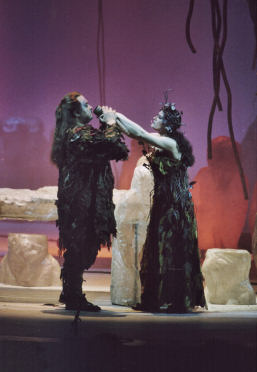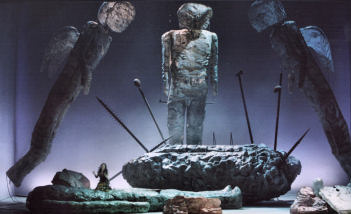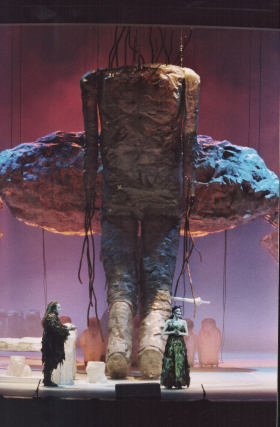|
Editorial Board
Melanie
Eskenazi
Webmaster: Len Mullenger
|
Seen and Heard Opera Review
The Mariinsky
Ring
in Cardiff - Die
Walküre:
Soloists and Orchestra of the Mariinsky Theatre, Valery
Gergiev (conductor) Wales Millennium Centre 01.12.2006
(GPu)
Staged by: Susanna Tsiriouk Set Design: George Tsypin
Costumes: Tatiana Noginova
Assistant Stage Director: Irina Kosheleva
Siegmund: Oleg Balashov Hunding: Gennady Bezzubenkov Wotan: Mikhail Kit Sieglinde: Mlada Khudoley Brünnhilde: Olga Savova Fricka: Larissa Diadkova Gerhilde: Lia Shevtsova Ortlinde: Irina Vasilieva Waltraute: Elena Vitman Schwertleite: Lyudmila Lanunnikova Helmwige: Tatiana Kravtsova Siegrune: Nadezhda Vasilieva Grimgerde: Elena Sommer Rossweisse: Lyubov Sokolova
There
was much else that passed the Housman test too. There
was Larissa
Diadkova’s Fricka, an extraordinarily powerful presence,
both dramatically and vocally; there was a skin-bristling
frisson throughout the Scene II confrontation between
her and Mikhail Kit’s Wotan, a confrontation both resonantly
epic and plausibly ‘domestic’. The Brünnhilde of Olga
Savova was occasionally swamped by the weight of orchestral
sound, but at other times was thrillingly bell-like. In
Scene II Sieglinde’s distress was harrowingly articulated
by Mlada Khudoley, and the whole relationship between
Sieglinde and Siegmund (Oleg Balashov) was touchingly
done, growing convincingly from tentative beginnings,
both musically and dramatically. Mikhail Kit’s Wotan was
movingly vulnerable, vocally best when at his most confiding
and intimate, persuasively central to Wagner’s exploration
of the paradoxes of love and power. Musically the Walkyrie
were impressive – mine obviously wasn’t the only spine
to feel the shiver or whose throat was constricted – and
Wotan’s farewell to Brünnhilde surely brought “a precipitation
of water” to more eyes than just mine.
The
four huge, looming figures which, in various configurations,
dominate the stage give proceedings a sense of primeval
power. They seemed like neglected idols of a half-forgotten
cult, or a reminder of gods more ancient than Wotan and
his family. Their presence worked to suggest that other
gods had come and gone before, that gods are not ‘eternal’,
that a ‘cycle’ (or cycles?) such as the one these operas
enact had happened at least once before. These huge maimed
bodies spoke of the vulnerability of the human (and divine)
figures whose ‘grand’ actions were placed and judged by
the presence of these silent watchers and listeners. Was
it only my fancy that saw in the large rock (presumably)
with which they shared the stage, something which in certain
lights (and the lighting and costumes were marvellous
throughout) looks like a human cerebellum? The resemblance
was just enough to suggest – without dogmatic thesis making
– a kind of less systematic Jungian reading of Wagner’s
work of the sort familiar from Robert Donnington’s book
on The Ring.
To judge by the very highest theatrical standards, it might be said that not all the elements in the production were fully integrated into an utterly coherent whole, so that the effect was, as it were, additive rather than absolutely organic. But for all such reservations, this was a powerful evening’s opera.
All pictures :
© George Tsypin or Natasha Razina Back to the Top Back to the Index Page |
| ||
|
||||





